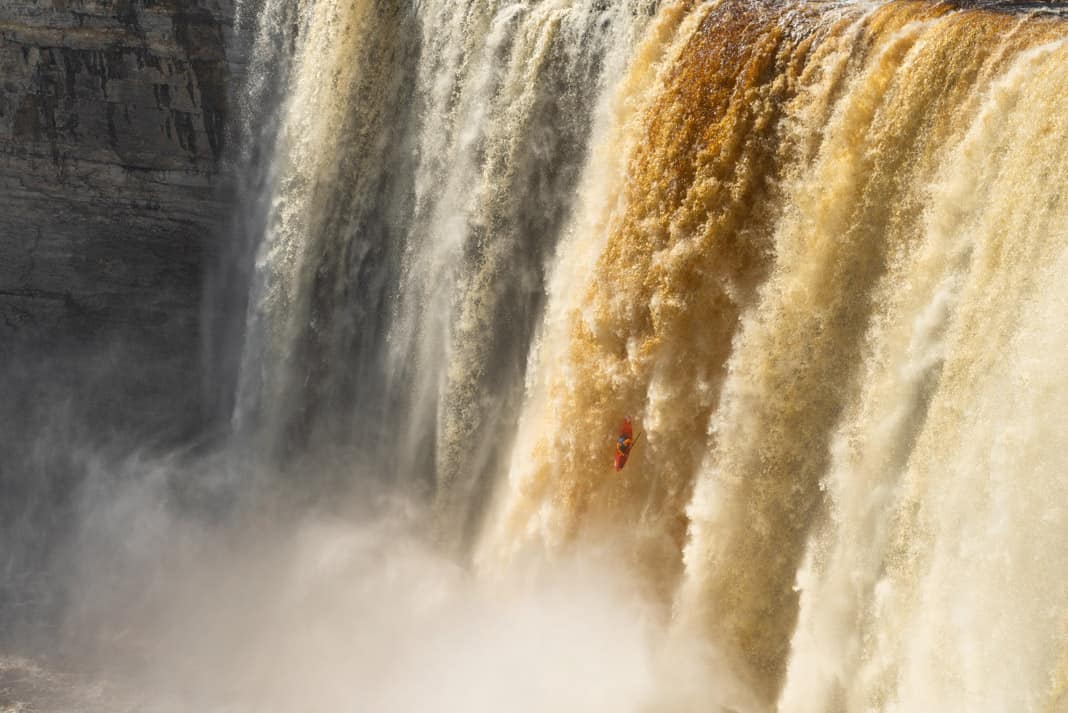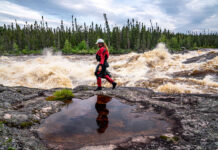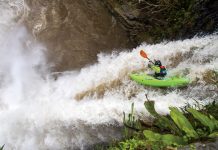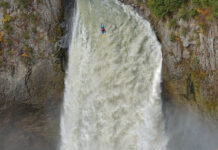On April 29, 2009, Tyler Bradt set a new world record when he successfully descended 186-foot-tall Palouse Falls in Washington State. In doing so, Bradt smashed his own previous world record, made two years earlier on 107-foot Alexandra Falls in Canada’s Northwest Territories. Bradt also provided a new high-water mark for others to measure themselves against. Among the small group of elite athletes who specialize in “dropping,” or kayaking over big waterfalls, no height seems out of reach.
Can kayakers conquer even bigger waterfalls?
In the decade since Bradt’s world-record run, a dozen or so waterfalls with heights more than 100 feet have been successfully run by a handful of athletes. Kayaking over such big waterfalls, freefall lasts 2.5 to 3.75 seconds, and impact speeds range from 35 to 60 miles per hour.
Leading up to his most recent world record attempt, Bradt was confident in his skill but concerned about his spraydeck staying on his kayak in the pressure at the bottom of the falls. Not only does an intact spraydeck create buoyancy, but a descent is only considered successful if the kayaker stays in his boat.
“We rely equally on athleticism and our equipment. The more extreme the sport, the more critical the role equipment plays,” Bradt says. “Any sport pushed beyond the limitations of gear can be incredibly dangerous.”
“All we are waiting for now is the next perfect drop to be found.”
A homemade solution to keep you in place
For his descent, Bradt invented what he calls a chastity belt. The system keeps his deck from imploding when the kayak hits the surface at the bottom of a big drop. “The chastity belt allowed me to run Palouse with a higher degree of safety and also ensured I remained in my boat at the bottom to set the world record,” he says. In Bradt’s case, the chastity belt was a big piece of the puzzle to try kayaking such a monstrous waterfall.
“The biggest issue we face in terms of gear is we are such a small segment of action sports, so anything you want to do, you have to do Tyler-style—100 percent homemade and home-tested,” says Rafa Ortiz, who notched the first descent of 129-foot Big Banana Falls in Mexico, currently the second tallest drop on record. Ortiz was also the second athlete to descend Palouse Falls.
“I think athletes are pushing the big drop game pretty strong and the gear and boat technology is where it needs to be,” says Send’s Adrian Mattern. “All we are waiting for now is the next perfect drop to be found.”
Picking the perfect waterfall
A perfect waterfall must have several features, including a lip allowing a kayaker to calmly come to the edge and stare down the landing, a flow rate adequately breaking the surface tension of the pool, an open pool at the base with no caves, and the ability to set safety behind the curtain.
“Progression is only as good as the athlete
pushing the sport,” says Dane Jackson
For Mattern and Send co-founder Bren Orton, 2018 was a colossal year. Both notched a descent on Mexico’s Big Banana Falls and Canada’s Alexandra Falls. “No single piece of equipment will facilitate progression in sending taller drops. Pushing height will come with the right person and the right waterfall,” says Orton. “As big waterfalls become more standard, we can only hope specific safety features will be built into kayaks to prevent injury or death. Much like racing restraints in a race car don’t help a driver go faster around the track, but by God do you want one if you crash.”
Gear advancements alone won’t take the sport to mega heights, but the minimal gains can go a long way. Similar to Bradt inventing a way to ensure his spraydeck would not implode on Palouse, a more compact life jacket without compromising flotation and sleeker helmet design could assist a kayaker in being able to tuck tighter and be as hydrodynamic as possible upon impact. Outfitting to reinforce the integrity of boat design is another often wish-listed feature for high flying boaters.

How big is too big to drop?
To break the current world record, kayakers will have to consider more than just personal skill and safety. “We don’t know what is possible because we have not seen the drop. There is a chance the next waterfall discovered is 191 feet tall, just breaking the record,” says Mattern. “In this case, we know a body can sustain a descent. However, the next waterfall could be 220 feet or higher, and we will be forced to look into whether a human can withstand the impact.”
Kayaking off a waterfall more than 220 feet high would entail at least four seconds of freefall and a big impact—more than 60 miles per hour.
“Progression is only as good as the athlete pushing the sport,” says Dane Jackson who has successfully descended four waterfalls in the triple-digit club. “It comes down to continuing to develop new techniques for adjusting angles and keeping the boat in control during freefall.”
This entails athletes spending time on smaller waterfalls, getting accustomed to freefall and dialing in the ability to make micro-adjustments. Mid-air mindfulness is key to controlling the angle of the kayak in search of the most hydrodynamic—and therefore least forceful—impact at the bottom of the falls.
Kayaking big waterfalls means scaling new heights
“As someone who has run the two highest waterfalls, I know we can go higher,” says Ortiz. “It’s not for me anymore, but I know there will be kids who want to go taller and who will find a way.”
This article was first published in Issue 56 of Paddling Magazine. Subscribe to Paddling Magazine’s print and digital editions, or browse the archives.









OMG ….. Death wish.
No, but a Life Wish. It isn’t how you want to die, but how you want to live.